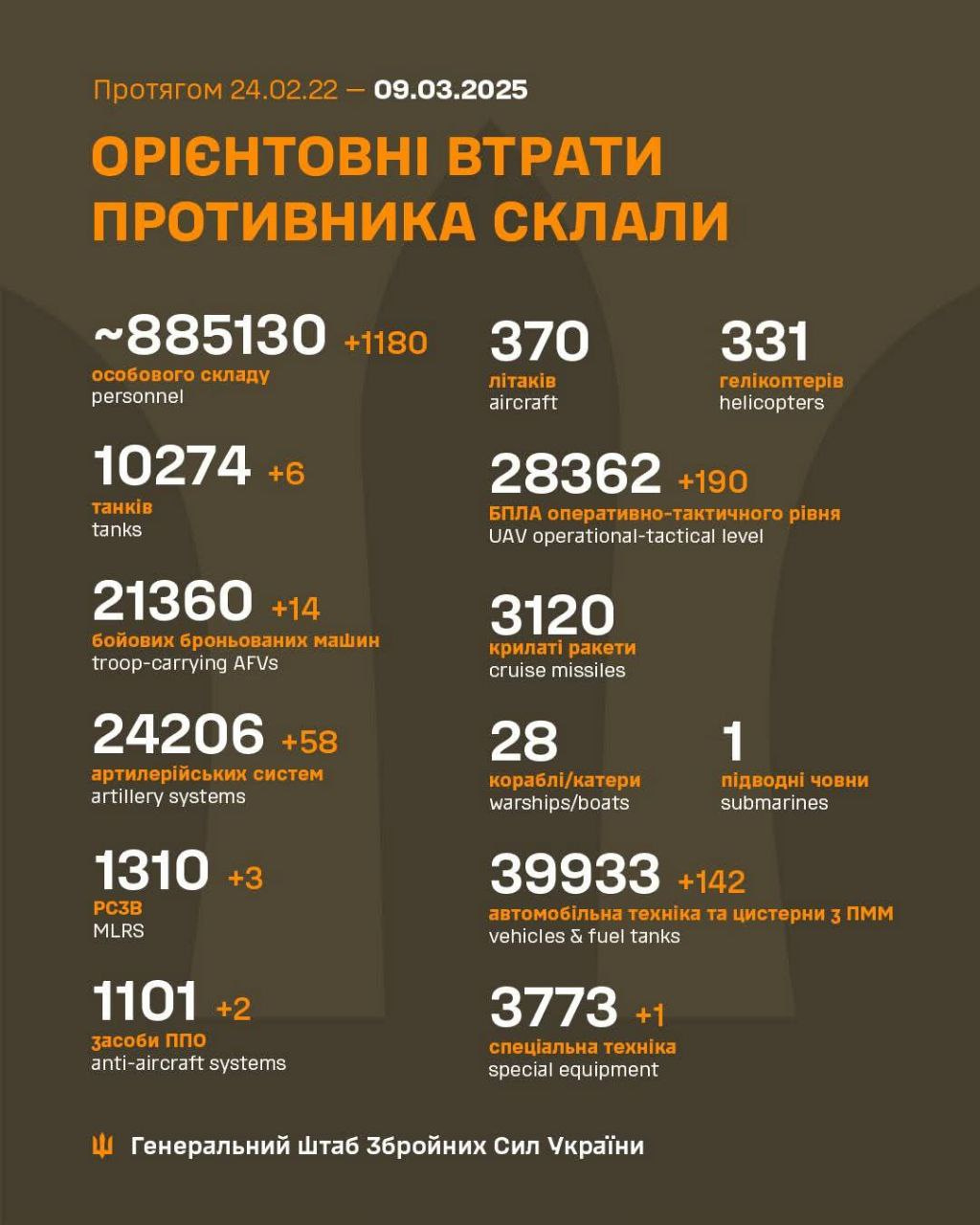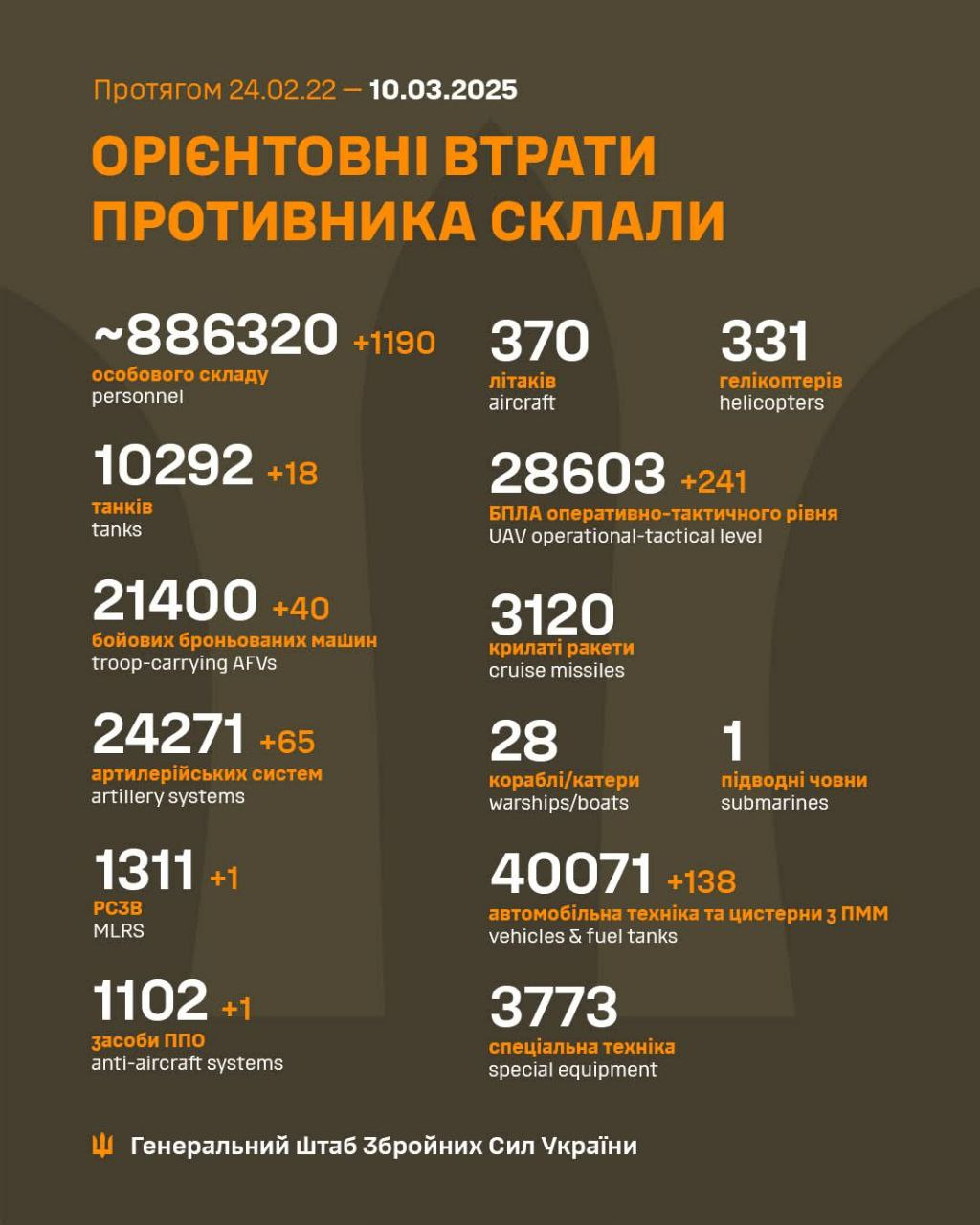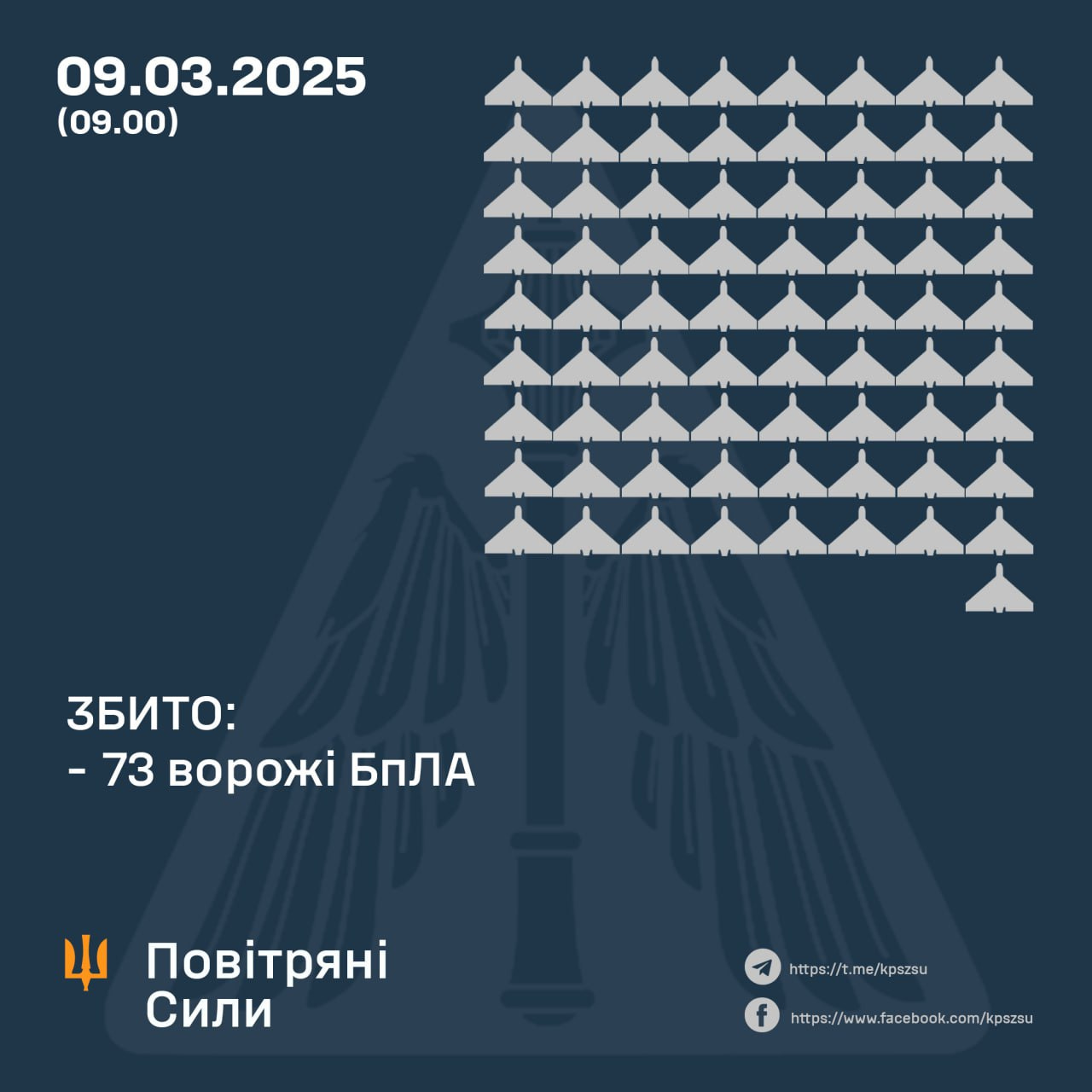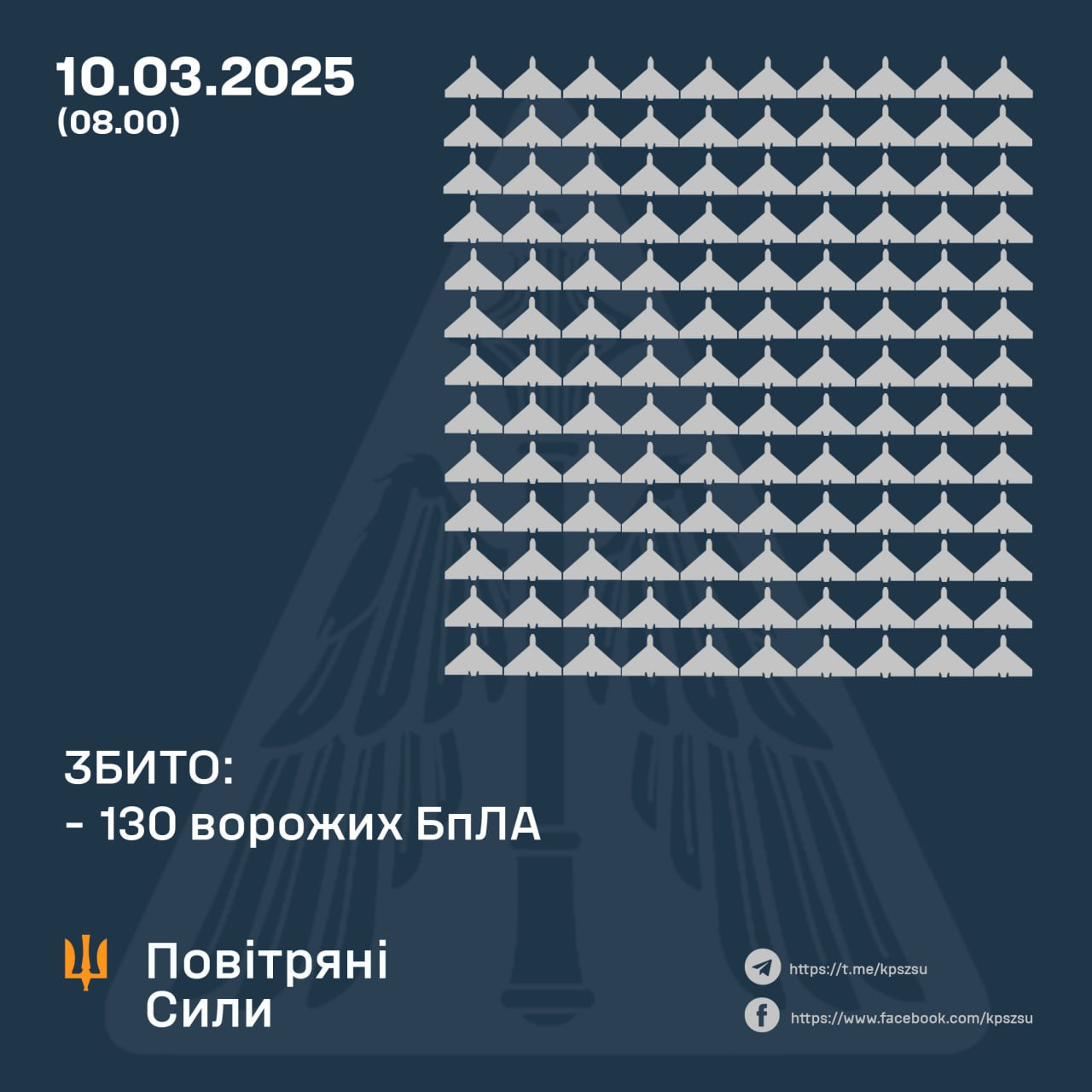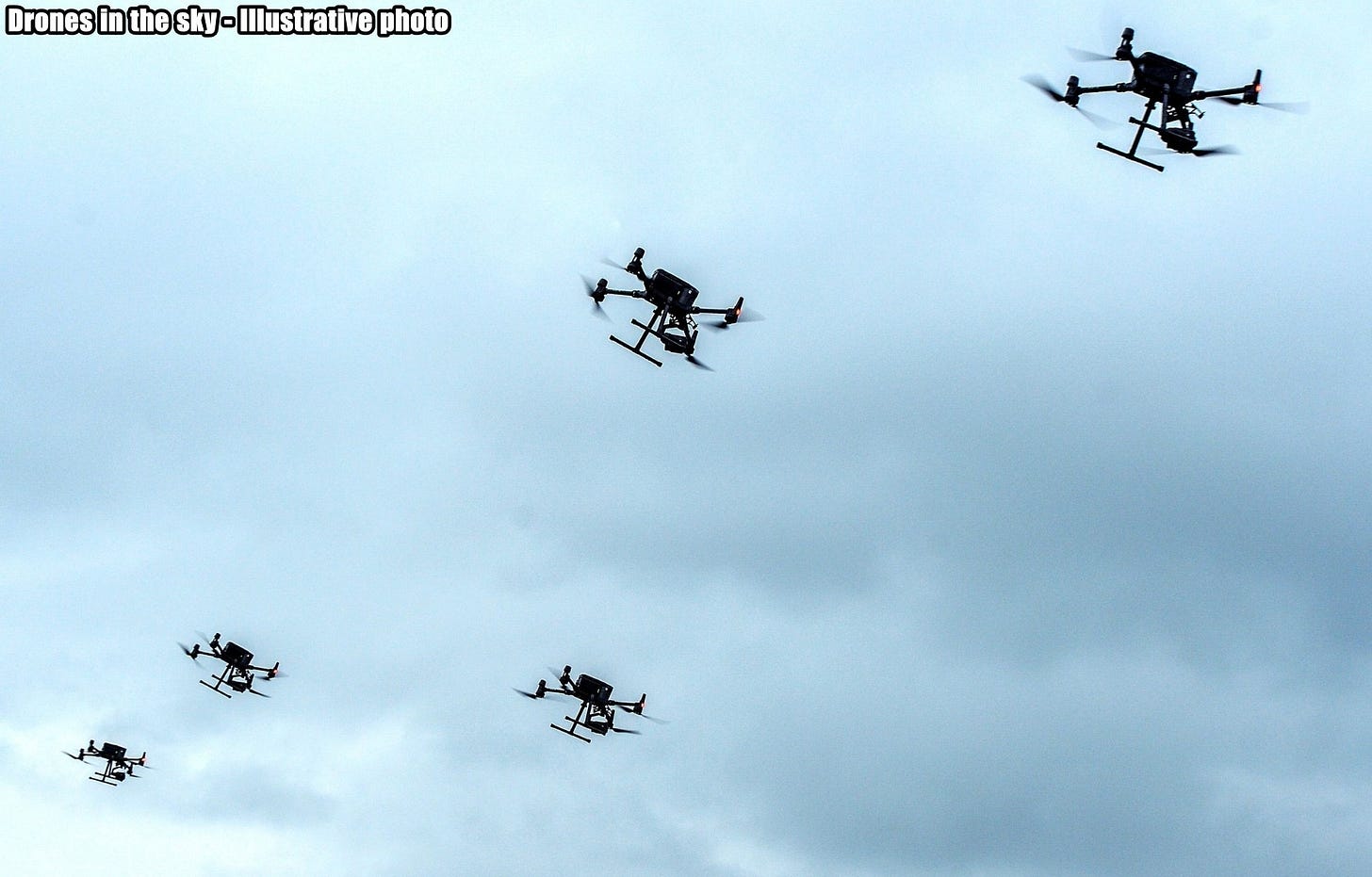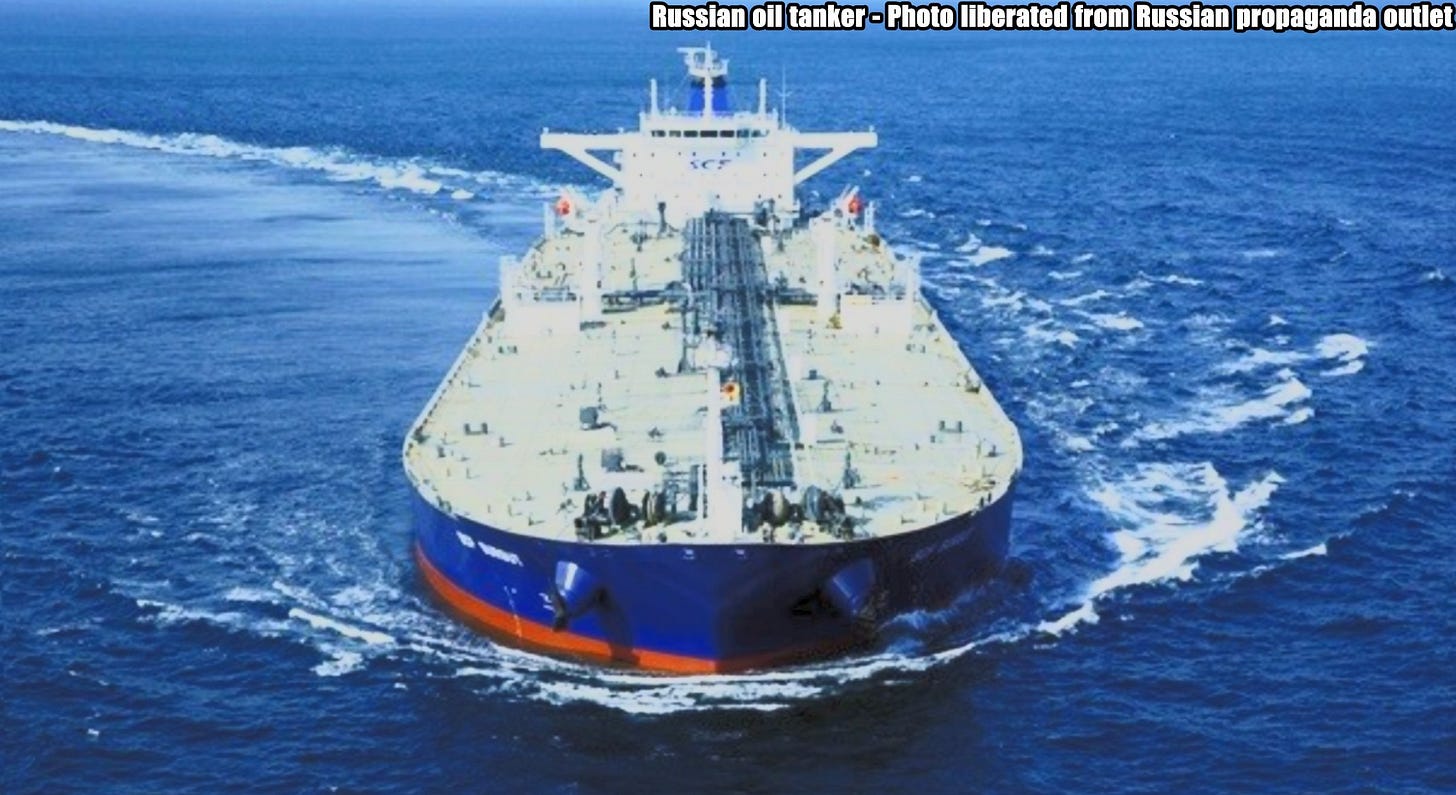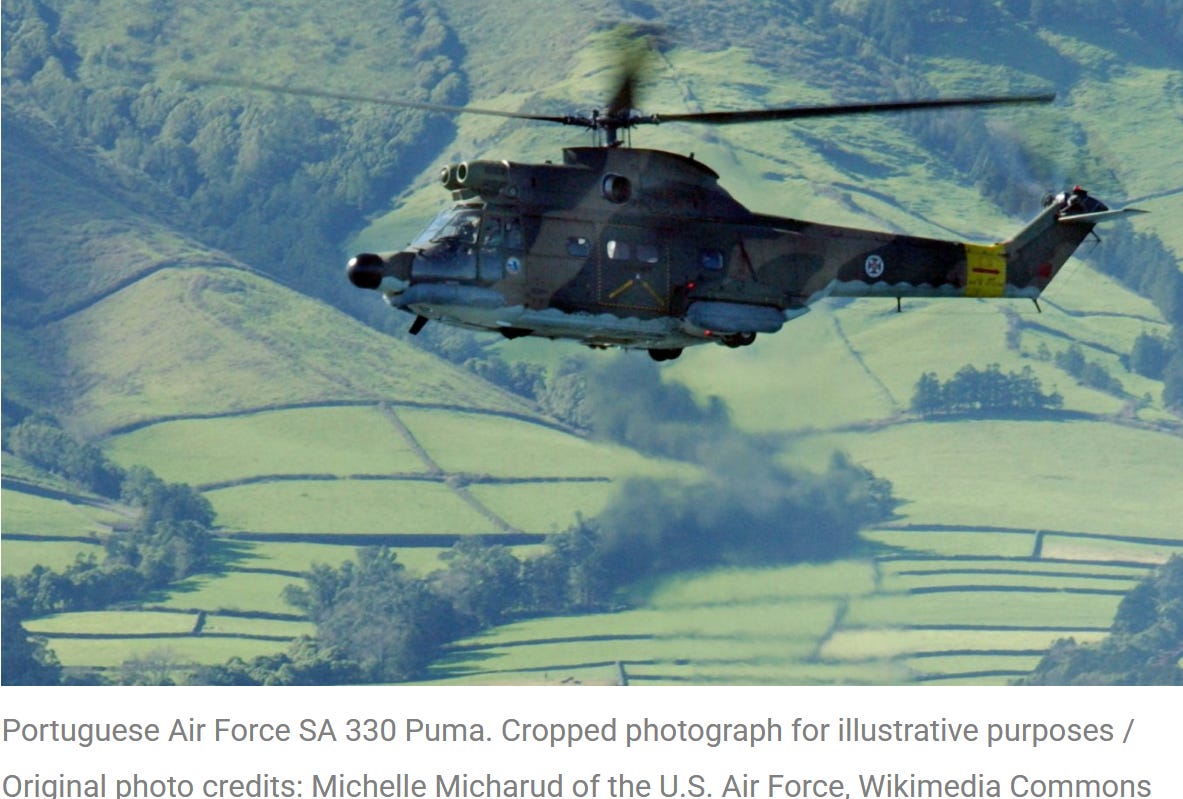Slava Ukraini! In early 2022 I began a Telegram channel aggregating news from a number of sources daily on the war in Ukraine. In June 2023 I began providing a daily draft for the Ukraine War Brief Podcast collecting news from over 70 sources daily, which formed the basis of the script. While the Podcast no longer exists I have continued to make this Brief available for my followers here on Substack for those who wish to keep up with the news from the war.
All the latest news on the Russo-Ukraine War 6 days per week
ALONG THE CONTACT LINE
GSAFU Morning Report
The General Staff of the Armed Forces of Ukraine in its Operational Information update at 08:00 on Mar 10 stated that day 1111 of the full-scale invasion of the Russian Federation against Ukraine had begun.
The situation on the line of combat remains tense in some sectors. Ukrainian defenders continue to actively counteract the Russian aggressor, causing them significant losses in personnel, equipment and technology. Exhausting the enemy along the entire front line and continuing to disrupt the plans of Russian occupiers to advance deeper into the territory of Ukraine.
During the past two days, 318 combat engagements took place.
Over the past 48 hours, the enemy carried out 3 missile strikes, 174 air strikes, used 5,805 drones and fired approximately 12,900+ artillery shells across the positions of Ukrainian forces and civilians.
Air Force Daily Report
73 ENEMY UAVS SHOT DOWN, 37 DRONES FAILED TO REACH THEIR TARGETS (LOCATIONALLY LOST)
➖➖➖➖➖➖➖➖➖
On the night of March 9, 2025 (from 7:00 p.m. on March 8), the enemy attacked with 119 Shahed attack UAVs and simulator drones of various types from the following directions: Orel, Millerovo, Kursk, Bryansk, Primorsko-Akhtarsk - Russia, Chauda - Crimea.
The air attack was repelled by aviation, anti-aircraft missile troops, electronic warfare units, and mobile fire groups of the Air Force and Defense Forces of Ukraine.
As of 09:00, it was confirmed that 73 Shahed attack UAVs and drones of other types were shot down in Kharkiv, Poltava, Sumy, Chernihiv, Cherkasy, Kyiv, Kirovohrad, Zhytomyr, Khmelnytskyi, Dnipropetrovsk, Zaporizhia, and Mykolaiv regions.
37 enemy drones-simulators - lost in location (without negative consequences).
As a result of the enemy attack, the Donetsk region, Kharkiv region, Poltava region, Cherkasy region, Sumy region, and Zaporizhia region suffered.
130 ENEMY UAVS SHOT DOWN, 42 DRONES FAILED TO REACH THEIR TARGETS (LOCATIONALLY LOST)
➖➖➖➖➖➖➖➖➖
On the night of Mar 10, 2025 (from 6:00 p.m. on Mar 9), the enemy attacked with 176 Shahed attack UAVs and simulator drones of various types from the following directions: Shatalovo, Millerovo, Kursk, Bryansk, Primorsko-Akhtarsk - Russia, Chauda - Crimea.
The air attack was repelled by aviation, anti-aircraft missile troops, electronic warfare units, and mobile fire groups of the Air Force and Defense Forces of Ukraine.
As of 08:00, it has been confirmed that 130 Shahed attack UAVs and drones of other types have been shot down in Kharkiv, Poltava, Sumy, Chernihiv, Cherkasy, Kyiv, Kirovohrad, Zhytomyr, Vinnytsia, Dnipropetrovsk, Zaporizhia, Donetsk, Odesa, Mykolaiv and Kherson regions.
42 enemy drones-simulators - lost in location (without negative consequences).
The Kharkiv, Poltava, and Kyiv regions were affected by the Russian attack.
Combat Operations in the Kursk Sector, Russian Federation
The Institute for the Study of War (ISW), a US based think tank, in its Mar 8 Russian Offensive Campaign Assessment reported that Russian forces intensified their multi-directional campaign to eliminate the remaining Ukrainian salient in Kursk Oblast on Mar 7 and 8.
Geolocated footage published on Mar 8 indicates that Russian forces recently seized Cherkasskoye Porechnoye (north of Sudzha).
An unnamed Ukrainian commander operating in Kursk Oblast told the New York Post that roughly eight to 10 Russian vehicles recently broke through Ukrainian positions near Sudzha and were able to swiftly advance — likely referring to recent Russian advances south of Sudzha between Kurilovka and Guyevo.
Russian and Ukrainian sources reported that Russian forces attempted to covertly attack behind Ukrainian positions in Sudzha via an underground gas pipeline but issued contradictory claims about the outcome of the attack. Russian sources reiterated that Ukrainian forces maintain positions in Sudzha and claimed that some Ukrainian forces are falling back to Sudzha from positions north of the town.
- - - - - - -
Russian forces are collapsing the northern part of the Ukrainian salient in Kursk Oblast following several days of intensified Russian activity in the area. Geolocated footage published on March 8 indicates that Russian forces seized Novaya Sorochina (northwest of Sudzha), Malaya Loknya (just south of Novaya Sorochina), and Lebedevka (south of Malaya Loknya), and the fields between the settlements.
Russian forces reportedly advanced in Sudzha itself with support from North Korean forces. Russian milbloggers claimed that Russian forces advanced into the industrial area in northeastern Sudzha and that Russian forces maintain positions in the town along the east bank of the Sudzha River.
Ukrainian sources told the Ukrainian outlet Suspilne on March 9 that up to two battalions of North Korean forces operating near Sudzha appear to be better trained and "acting more coherently."
Russia is capitalizing on America’s betrayal in Kursk
The Institute for the Study of War (ISW), a US based think tank, in its Mar 9 Russian Offensive Campaign Assessment reported that the temporal correlation between the suspension of US intelligence sharing with Ukraine and the start of Russia's collapse of the Ukrainian Kursk salient is noteworthy. Russia has been attempting to push Ukrainian forces from the salient in Kursk Oblast through slow, grinding advances since the incursion began in Aug 2024.
Russia later deployed roughly 12,000 North Korean military personnel in Oct 2024 to assist in repelling the incursion, but Russian forces continued to make only gradual gains. The Trump administration suspended US intelligence sharing with Ukraine on Mar 5, although there continue to be conflicting reports about the details about the US suspension. Russian forces intensified offensive operations to expel Ukrainian forces from Kursk Oblast on Mar 6 and 7. A source reportedly affiliated with Ukrainian military intelligence started reporting more rapid Russian advances in Kursk Oblast on March 5.
A source in the Ukrainian government stated in a Mar 8 Time article that the US intelligence sharing suspension has impacted Ukrainian operations in Kursk Oblast the most. The Russian military has not previously prioritized the effort to push Ukrainian forces out of Kursk Oblast over making further advances in eastern Ukraine despite concentrating a sufficient force grouping to do so in late 2024. A direct link between the suspension of US intelligence sharing and the start of the collapse of Ukraine's salient in Kursk Oblast is unclear, although Kremlin officials have recently announced their intention to take advantage of the suspension of US military aid and intelligence sharing to "inflict maximum damage" to Ukrainian forces "on the ground" during the limited time frame before the possible future resumption of US intelligence sharing and military aid to Ukraine.
Reports about the extent of the suspension of US military aid to Ukraine continue to indicate that the suspension will likely affect Ukraine's ability to defend itself against Russia. Forbes stated on Mar 7 that the Trump administration has halted US support for Ukraine's F-16 fighter jet radar jammers. The Wall Street Journal reported on Mar 8 that a source familiar with the matter stated that Ukraine is currently able to fire one artillery shell for every three that Russian forces fire – even with Ukraine's current supplies of US shells. The suspension of US support to Ukrainian F-16 radar jammers will likely hamper Ukraine's ability to continue to use the aircraft to defend against Russian strikes into Ukraine's rear. Ukrainian officials indicated in Dec 2024 that Ukrainian forces had been able to gain an artillery advantage of 1.5 to one or three-to-one in some areas of the front, and Russia's current artillery advantage over Ukraine will likely continue to grow as Ukraine's stockpiles of US ammunition decrease further following the US suspension of military aid.
Russia Strikes Bridges, Attempts To Cut Off 10,000 Ukrainian Troops In Kursk.
The 10,000-strong Ukrainian garrison in western Russia’s Kursk Oblast is in trouble, David Axe writes for Forbes.
Relentless strikes by an elite Russian drone group have destroyed hundreds of vehicles along the main road into Kursk to the town of Sudzha, the anchor of the shrinking Ukrainian salient in the oblast.
Exploiting the Ukrainian Siversk Operational Tactical Group’s increasingly dire supply situation, the much larger Russian and North Korean force in Kursk has redoubled its three-month counteroffensive in Kursk.
Ukrainian brigades on the northern edge of the salient are pulling back to Sudzha, where Ukrainian troops recently rebuffed an attempt by Russian troops to infiltrate Ukrainian lines by sneaking through an old gas pipeline.
The repositioning could be a prelude to a complete Ukrainian withdrawal from Kursk back to the relative safety of northern Ukraine.
Shrugging off at least one raid by a Ukrainian air force Mikoyan MiG-29, the Russians are moving to cut off any retreat. “The enemy is destroying bridges in Kursk Oblast and along the international border, trying to hinder the movement of the Siversk Operational Tactical Group from exiting Kursk Oblast into Ukraine,” the Ukrainian Center for Defense Strategies warned.
The Siversk OTG was actually gaining ground as recently as early February. But the arrival of the Russian Rubicon Center of Advanced Unmanned Systems later that month changed everything.
“Rubicon employs advanced drone tactics,” independent analyst Andrew Perpetua explained. Worse, its explosive first-person-view drones seem to fly right through Ukrainian radio jamming.
A flurry of Russian drone strikes on the road into Sudzha on or just before Feb. 25—dozens in all—signaled the likely beginning of the end of Ukraine’s seven-month incursion in Kursk. “The day you saw this should’ve been the day you started worrying about Kursk,” Perpetua wrote.
The successful Russian drone campaign in Kursk came as U.S. President Donald Trump—increasingly aligned with Russia—cut off Ukraine from further U.S. aid and also ended intelligence sharing between the United States and Ukraine.
Ukraine’s European allies could replace much of the intel the Ukrainians are no longer getting from the Americans. But the switch could take time. And it’s apparent the Russians are seizing the opportunity afforded them by Trump’s pro-Russian lurch.
The Khortytsia operational-strategic group
(Responsible for the northeastern part of Ukraine. )
Toretsk Sector: Ukrainian and Russian forces recently advanced in the Toretsk direction.
Geolocated footage published on March 8 indicates that Ukrainian forces recently advanced on Druzhby Street in central Toretsk and on Budivelnykiv Street in southern Toretsk.
Geolocated footage published on March 7 indicates that Russian forces recently advanced along Voronezska Street in western Toretsk.
The Tavria operational-strategic group
(Responsible for the central-eastern and southeastern part of Ukraine.)
Pokrovsk Sector : Ukrainian and Russian forces recently advanced in the Pokrovsk direction.
Geolocated footage published on Mar 6 indicates that Ukrainian forces recently advanced along Horkoho Street in southwestern Lysivka (southeast of Pokrovsk). Russian milbloggers claimed that Ukrainian forces advanced along Kalynova Street in northern Shevchenko (south of Pokrovsk).
Geolocated footage published on Mar 7 indicates that Russian forces recently advanced in southeastern Udachne, south of Preobrazhenka (both southwest of Pokrovsk), and south of Zaporizhzhia (south of Preobrazhenka).
The Odesa operational-strategic group
(Responsible for Kherson, Qırım, (also known as Crimea) and the Black Sea.)
There have been no major changes to the combat environment since our last report.
TEMPORARILY OCCUPIED TERRITORIES
Nothing major to report.
THE HOME FRONT
SBU arrests Kharkiv resident suspected of bombing, poisoning plot on Russia's behalf.
Ukrainian security forces have detained a suspected agent of Russian intelligence who allegedly orchestrated an explosion near a war veteran’s home and poisoned a soldier under the guise of providing volunteer aid, the Kyiv Independent reported citing the Security Service of Ukraine (SBU) on Mar 10.
According to the investigation, the suspect, an IT specialist from Kharkiv, was recruited by Russian intelligence services and tasked with assembling improvised explosive devices (IEDs) containing metal fragments to maximize casualties.
She allegedly hid one of the devices in a designated cache, where an accomplice retrieved it and placed it near the home of a Ukrainian army veteran. The explosion injured the veteran, who was later hospitalized.
The SBU also accused the woman of poisoning a soldier by lacing food and medicine with toxic substances while posing as a volunteer. The serviceman was hospitalized and is in serious condition.
Investigators believe Russian intelligence operatives first approached the suspect before the full-scale invasion when she was visiting relatives in Russia. By early 2025, she was receiving direct instructions from her handlers, the SBU said.
Authorities are now investigating her potential involvement in other crimes. The court has ordered her detention without bail while the case proceeds.
RUSSIAN WORLD
Ukraine strikes Samara Oblast refinery producing fuel for Russian jets, bombers, source claims.
Ukrainian military intelligence's (HUR) drones struck the Novokuybyshevsk oil refinery in Russia's Samara Oblast overnight on March 10, a source in the agency reported to the Kyiv Independent, confirming earlier reports.
The statement came after Russian and Ukrainian sources reported an attack against the facility earlier the same day. Ukraine has systematically targeted Russian oil refineries, military sites, and warehouses deep behind the front lines to undermine Moscow's capacity to wage its all-out war.
The refinery's "capacity amounts to 8.8 million metric tons of oil per year, making it one of the 10 largest (refineries) in Russia," said Andrii Kovalenko, head of the Center for Countering Disinformation at Ukraine's National Security and Defense Council.
The plant produces gasoline, diesel fuel, and fuel oil, "which are critically important for transport and military equipment," the official added. This includes jet fuel used by supersonic aircraft such as Su-27 fighter jets and Tu-22 bombers, the HUR source claimed.
Samara Oblast residents reported loud explosions overnight, Astra wrote, adding that a fire was recorded at the Rosneft-run oil facility. According to the HUR source, the facility was hit at around 2 a.m. local time. The refinery was not sufficiently protected by anti-drone defenses, the source added.
The city of Novokuybyshevsk lies roughly 900 kilometers (560 miles) from the front line in Ukraine. The facility was previously attacked at least twice in March 2024.
"This refinery is strategically important for the Russian military as it ensures a stable fuel supply for military operations," Kovalenko said.
The Russian propaganda agency RBC reported a fire at a warehouse in Novokuybyshevsk that covered an area of 1,500 square meters later the same day, without mentioning a drone attack. No casualties were reported.
Russia's Defense Ministry claimed its forces had shot down nine Ukrainian drones overnight, including three over Samara Oblast, two each over the Voronezh and Oryol oblasts, and one each over the Belgorod and Kursk oblasts.
On March 9, a Ukrainian drone reportedly attacked an oil depot in Cheboksary in Russia's Chuvashia Republic, marking the first strike against the region.
RELATED INTERNATIONAL NEWS
America vetoes G7 proposal to combat Russia’s shadow fleet of oil tankers.
US pushes to remove references to sanctions and Russia’s war in Ukraine from a Canadian draft statement, the Guardian reports.
The US has rejected a Canadian proposal to establish a task force that would tackle Russia’s so-called “shadow fleet” of oil tankers, according to reports last night.
Canada, which has the current Group of Seven presidency, proposed the measure ahead of a meeting of G7 foreign ministers in Quebec later this week.
In negotiations to agree to a joint statement on maritime issues, the US is pushing to strengthen language about China while watering down wording on Russia, the reports said.
The “shadow fleet” refers to ageing oil tankers, the identities of which are hidden to help circumvent western economic sanctions imposed on Moscow since it launched its full-scale military invasion of Ukraine at the start of 2022.
As well as vetoing Canada’s proposal to establish a task force to monitor sanctions breaches, the draft G7 statement seen by Bloomberg News shows the US pushed to remove the word “sanctions” as well as wording citing Russia’s “ability to maintain its war” in Ukraine by replacing it with “earn revenue”.
G7 communiqués are not final until they are published through consensus. Further talks could still result in changes to the end-of-summit statement.
US diplomats briefed their G7 counterparts that the move was because of Washington’s “re-evaluation of its position in multilateral organisations, rendering it unable to join any new initiatives”, according to the Bloomberg report.
European countries are discussing plans that will let them carry out seizures of Moscow’s oil-exporting tankers in the Baltic Sea.
The proposals include using international law to allow them to take control of vessels on environmental or piracy grounds.
Trump says US has "just about" ended pause on Ukraine intel sharing.
U.S. President Donald Trump said on Sunday that the United States had "just about" ended a suspension of intelligence sharing with Ukraine, and that he expects good results out of upcoming talks with Ukrainian officials in Saudi Arabia. Reuters reports.
Asked if he would consider ending the suspension, Trump said, "We just about have. We just about have."
CIA Director John Ratcliffe said on Wednesday the U.S. had halted intelligence sharing with Ukraine, piling pressure on Ukrainian President Volodymyr Zelenskiy to cooperate with Trump in convening peace talks with Russia.
The suspension, which could cost lives by hurting Ukraine's ability to defend itself against Russian missile strikes, followed a halt to U.S. military aid to Kyiv.
U.S. officials will meet on Tuesday with a Ukrainian delegation in Saudi Arabia in part to determine whether Ukraine is willing to make material concessions to Russia to end the war. Also hanging over the talks in Jeddah is the fate of a minerals deal between Washington and Kyiv.
Trump expressed optimism about the talks. "We're going to make a lot of progress, I believe, this week," he said.
Zelenskyy and Trump had been slated to sign the minerals accord - which would give the U.S. access to certain mineral resources in Ukraine - before Zelenskiy's White House visit erupted into a clash between the two leaders, after which it was not signed.
Trump said on Sunday he thought Ukraine would sign the minerals agreement, which Ukraine wants to contain a U.S. security guarantee.
"They will sign the minerals deal but I want them to want peace... They haven't shown it to extent they should," he said.
Trump also said his administration was looking at a variety of things with respect to tariffs on Russia and that administration officials are not concerned about military exercises involving Russia, China and Iran.
UK prepares to unlock $3bn from Chelsea sale for Ukraine.
British Foreign Secretary David Lammy has promised to take steps to release 2.3 billion pounds ($3 billion) received from the sale of "Chelsea" football club by Russian billionaire Roman Abramovich to help Ukraine, Lammy said in an interview with the Financial Times.
The funds received from the sale of "Chelsea" in May 2022 have remained blocked in a special trust account for more than two years. The British government wants to use these funds to support Ukraine, but negotiations on their use have been delayed.
"I'm disappointed that it hasn't happened, that's the truth - and that the money needs to be distributed, it needs to be used," Lammy said.
The minister stressed that he is taking an ‘action-oriented approach’ to resolve the situation, and while going to court would take time, it is an option under consideration. Another way is to conclude an agreement with a fund that will manage the funds.
At the same time, Lammy acknowledged the legal difficulties, but assured: "I am determined to see this money get out the door and I will do everything in my power to make that happen."
The UK government insists that the money should be spent exclusively within Ukraine. Instead, the controversial foundation, which includes former UNICEF UK Executive Director Mike Penrose, insists on flexibility to support Ukrainian refugees abroad.
MILITARY & TECH
Ukraine, German arms maker seek to triple IRIS-T air defense supply.
Ukraine has signed a memorandum with German defense manufacturer Diehl Defense to triple the supply of IRIS-T air defense systems and missiles, Defense Minister Rustem Umerov announced on Mar 9, the Kyiv Independent reported.
The deal comes as Ukraine faces intensified Russian aerial assaults, including Russia’s strike on Feb. 23, which marked the single largest drone attack since the start of the full-scale invasion.
"The signed agreement paves the way for large industrial projects that will strengthen the capabilities of Ukraine's air defense," Umerov wrote on Facebook.
The IRIS-T is a modern surface-to-air missile system capable of countering aircraft, helicopters, drones, and cruise missiles.
Germany has been a key supplier of the system, with outgoing German Chancellor Olaf Scholz announcing an order for 17 additional IRIS-T systems for Ukraine last September.
In late Dec, President Volodymyr Zelensky confirmed that Ukraine had received Germany’s sixth IRIS-T battery.
Portugal Delivered Eight Retro SA 330 Puma Helicopters to Ukraine.
Portugal had sent eight Aérospatiale SA 330 Puma helicopters to aid the Ukrainian Defense Forces in late 2024, the latest public release from the Portuguese Ministry of Defense confirms. The initial announcement came from the country's Minister of National Defense, Nuno Melo. As reported by Publico, in January 2025, he retrospectively mentioned a provision of eight Puma helicopters to Ukraine, but the timeline wasn't specified, Defense Express reports.
Aérospatiale SA 330 Puma was designed back in the 1960s but is still regarded as a versatile and capable rotorcraft.
The delivery of SA 330 Puma was part of a broader commitment by Lisbon to donate €221 million worth of military equipment to the Ukrainian forces, including Ka-32 helicopters, M113 armored vehicles, 105-millimeter howitzers, boats, and more.
SA 330 Puma is a twin-engine, four-blade medium lift helicopter designed in the 1960s on request from the French Army for a reliable all-weather transport helicopter. It was produced from 1968 to 1987 until it gave way to its improved successor, AS 332 Super Puma.
In the Portuguese military, SA 330s were deployed for military operations, tactical air transport, search-and-rescue missions, and maritime surveillance. By the 2000s, Portugal switched over to AW-101 Merlin helicopters.
The Military Balance 2024 study counts 12 Merlins and also mentions five AW-119 Koala helicopters but, notably, no indications of Pumas being present in active service or military reserve as of early 2024. The FlightGlobal journal from 1987, however, does list 10 units of SA330C Puma at Portugal's disposal.
As for specifications, Puma is over 18 meters in length, with rotor wingspan of 15 meters. With an empty weight of 3.5 tons, it can take off at a maximum weight of 7 tons. The helicopter is piloted by a crew of three, with capacity for up to 20 passengers. It speeds up to 270 km/h traveling distances up to 580 km at altitudes below 4.8 km, although some sources claim it can ascend almost up to 6 km.
Russia experiments with new strike packages to attempt to defeat Ukrainian air defences.
The UK Ministry of Defence in their Mar 8 Intelligence Update on Ukraine stated that overnight Mar 6-7, Russia conducted its largest multi-axis long range aviation (LRA) strike of 2025. Alongside up to 35 As-23a Kodiak (Kh-101) air launched cruise missiles, Russia also launched land attack cruise missiles from Black Sea Fleet vessels alongside short range ballistic missiles and more than 100 one-way attack UAVs, all of which serve to complicate and saturate Ukrainian air defense efforts.
Russia continues to strike a range of targets, including the Ukrainian energy sector, predominantly gas infrastructure, seeking to exploit the winter period as it attempts to demoralise the civilian population as well as weaken Ukrainian economy.
The Kodiak (Kh-101) missile remains the pace setter for Russian large scale strike packages, with a number of lower-intensity strikes this year allowing a slow replenishment in the stocks of Russia's premier precision guided munition. Rebuilding its stockpile enables LRA to sit ready to conduct strikes such as these with little to no notice, at a time of russia’s choosing.
That’s it for today’s Brief folks if you would like to keep up with events in Ukraine daily please consider subscribing, it’s free!







